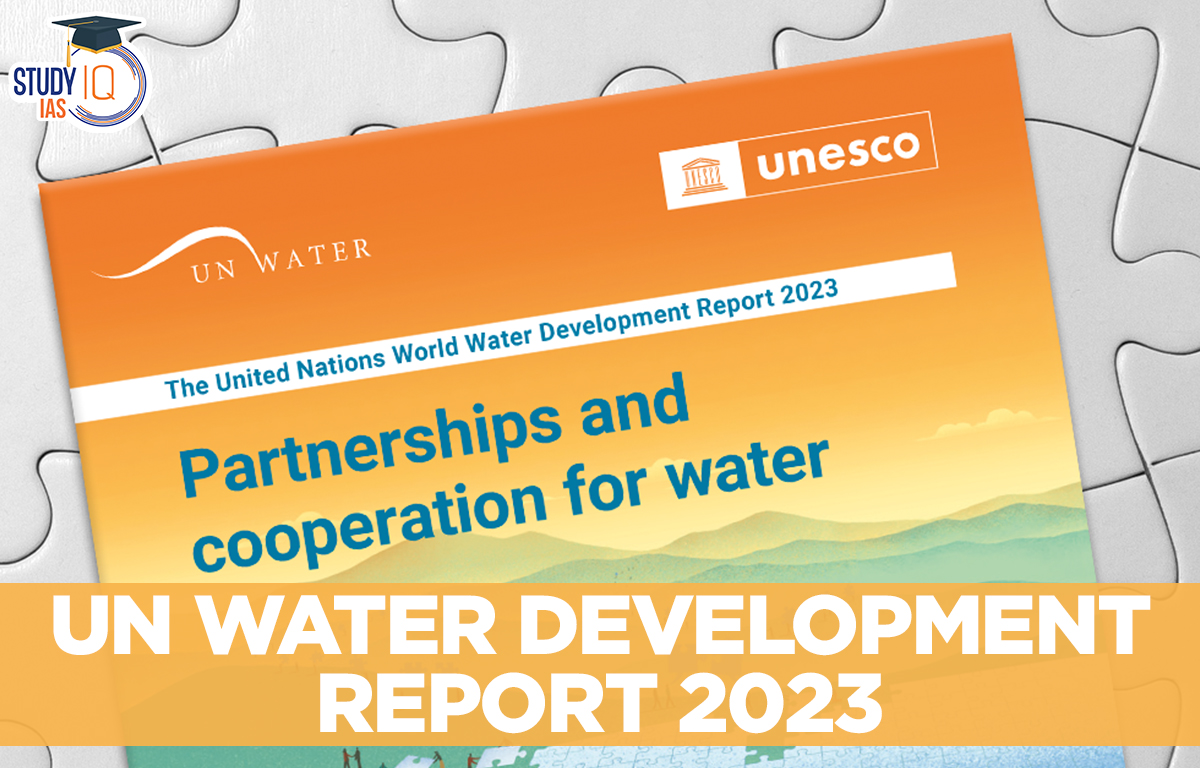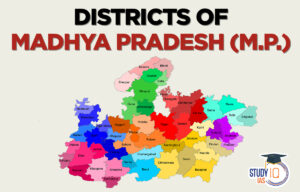Table of Contents
Context: The ‘United Nations World Water Development Report 2023: partnerships and cooperation for water’, has been published by UNESCO.
Highlight of Report
- The urban population facing water scarcity in the world is expected to double from 930 million in 2016 to between 1.7 and 2.4 billion people, in 2050.
- India: India will be most severely affected as the global urban population facing water scarcity is projected to rise in upcoming decades.
- World: Majority of the demand is concentrated in middle- and lower-income countries, particularly in emerging economies.
- Two billion people across the globe do not have safe drinking water and 3.6 billion lack access to safe sanitation.
- Vulnerable areas: As a result of excessive demand, seasonal water scarcity will increase in areas where it is currently abundant and worsen in areas where water is already in shortage.
- Impact: The rising cases of extreme and prolonged droughts are also stressing ecosystems, with dire consequences for both animal and plant species
- Water scarcity: Lack of sufficient available water resources to meet water usage demands within a region
- Water stress: The difficulty of obtaining fresh water sources during a period of time may lead to further depletion and deterioration of available water
- Water crisis: A situation where the available potable, unpolluted water within a region is less than that region’s demand
Important Parameters
Importance of Access to Water and Sanitation
Safe and equitable access to water and sanitation is a part of SDG6 targets.
- Access to safely managed drinking water services (Target 6.1)
- Access to safely managed sanitation (Target 6.2)
- Access to ambient water quality (Target 6.3)
- Water use efficiency (Target 6.4)
- Integrated Water Resource Management implementation (Target 6.5)
- Track changes in the extent of water-related ecosystems (Target 6.6)
Water Management Partnerships in Various Sectors
Agriculture
- Farmers can manage a common irrigation system through Water user associations (WUAs), which are in form of local institutions (e.g. village councils or religious groups), local non-governmental organizations (NGOs), and democratic internal processes.
- Imposition of central and national directives by governments has reduced the effectiveness of WUAs.
- As urban water demand has increased, water allocation from agriculture to urban centres has become a common strategy to meet freshwater needs in growing cities.
- The result is that less water is available for irrigation, leading to reduced food security and lower farmer livelihood incomes.
Environment
- Watershed protection measures address climate change adaptation by building resilience, and their role in mitigation is increasingly recognized.
- Apart from reducing infrastructure risks, ensuring compliance and reducing costs, these measures provide climate adaptation benefits, such as flood mitigation.
- Additional benefits of this approach include biodiversity conservation, and jobs and training opportunities.
- These partnerships will support water-related interventions that will serve objectives related to human health or climate change adaptation and mitigation.
- They also help in addressing the huge gaps in water quality data, helping to attract investment in upstream habitat protection and land management.
Human Settlement
- Private sector, NGOs and communities, along with government ministries and departments handle various aspects of water, sanitation and hygiene (WASH).
- Effective stakeholder involvement in planning and implementation leads to services that increase public acceptance and ownership of systems.
- NGOs and civil society will have to address complex dynamics that impact both displaced populations and host communities.
Industry
- Industry’s focus must be on collective action when desired outcomes cannot be obtained through internal or unilateral action alone.
- To be effective, companies must establish unconventional relationships with non-traditional partners. They must develop new skills and knowledge, such as greater understanding of community needs and values, and enhance their ability to connect with government actors and NGOs.
Health
- Fully functioning WASH services in health care facilities are necessary for delivering safe quality care. The existing issues are due to lack of coordination between different ministries, local authorities, international organizations, NGOs and private sector actors.
- Wastewater disease surveillance can complement diagnostic testing. Wastewater can be used as a part of a wider surveillance and control approach.
Climate Change
- Policymakers need to understand how climate-led processes work, and how best to integrate water-related climate risks into national water policies, strategies and implementation plans.
- Partnership between stakeholders will reduce disaster risks, deliver cost savings, boost job creation and generate economic opportunities for vulnerable communities.
Addressing Water and Related Issues
Partnerships and collaboration
- There is a need to explore opportunities through partnerships and cooperation to improve water governance and decision-making, stimulate innovative solutions, and leverages efficiencies.
Education and Capacity Development
- It will involve sharing of knowledge and skills between teachers, students, institutions, and other providers and recipients of information.
- Local knowledge and practices often shape water conservation. Cross-disciplinary partnerships that bring together scientists, water professionals and the broader public is the need of the hour.
Data gathering
- Data and information are critical to water-related decision-making. Partnerships can ensure that data is effectively gathered and processed into objective information.
- Joint monitoring of transboundary water resources will provide a platform where data can be shared and applied in a timely manner.
Innovative practices
- Innovation can be promoted through knowledge transfer, entrepreneurship and applied research. For this to take place, there is a need for knowledge sharing between governmental and non-governmental entities.
- Partnerships between water and sanitation industry will accelerate the uptake of new technologies for water processing, distribution and treatment.
- However, it must be ensured that innovations do not lead to unintended side effects, such as a widening the knowledge and socioeconomic divides.
Financing
- Equitable water distribution will require tripling current investment levels. Collaborations would generate additional funding for water related investments from various sources.
- Distribution of investment risks among multiple financiers, public or development finance can be used strategically to improve the risk–return profile of a project.
Governance
- To be successful, public–private partnerships (PPPs) have to build upon cooperation that is beneficial to all stakeholders.
- Both private sector and public sector operations are more effective in countries with clear, predictable and stable legislative frameworks, which support long-term investment.
Water Management in India
- Cross-border agreements: India has signed the Mahakali Treaty (Pancheshwar Multipurpose Project) with Nepal, which aims to achieve water and energy security for both parties.
- Traditional conservation: Using traditional knowledge on spring water availability and flood frequency, apart from water sowing and harvesting (e.g. paar systems in western).
- Private partnership: Google has started flood forecasting initiative in 2018, with the goal of preventing catastrophic damage in India and Bangladesh.
- Government programmes and schemes:
- Atal Bhujal Yojana: It is a Central Sector Scheme that seeks sustainable ground water management. It is partially funded from World Bank loan.
- It seeks community participation and demand side interventions for sustainable ground water management in certain water stressed areas in seven States of the country.
- PM Krishi Sinchayee Yojna (PMKSY): It is a centrally sponsored scheme to enhance physical access of water on farm and expand cultivable area under assured irrigation, improve on-farm water use efficiency, introduce sustainable water conservation practices, etc.
- Atal Mission for Rejuvenation and Urban Transformation (AMRUT): To develop basic infrastructure, in the selected urban areas, across sectors of water supply; storm water drainage; green spaces and parks; sewerage and septage management; and non-motorized urban transport.
- Jal Shakti Abhiyan: It promotes water conservation and water resource management by focusing on accelerated implementation of water conservation and rainwater harvesting, renovation of traditional water bodies, reuse of water and recharging of structures, intensive afforestation and watershed development.
- Mission Amrut Sarovar: It focuses on a target to construct or rejuvenate 50,000 Amrit Sarovar ponds across India, with an objective of promoting sustainable use of water.
- Sahi Fasal campaign: It is an awareness campaign with the objective of weaning away the farmers from growing water intensive crops and using micro-irrigation techniques to increase water use efficiency in agriculture.
- Atal Bhujal Yojana: It is a Central Sector Scheme that seeks sustainable ground water management. It is partially funded from World Bank loan.


 UNESCO World Heritage Sites of India Lis...
UNESCO World Heritage Sites of India Lis...
 Consolidated Fund of India, Meaning and ...
Consolidated Fund of India, Meaning and ...
 Districts of MP List, Name, Importance, ...
Districts of MP List, Name, Importance, ...





















